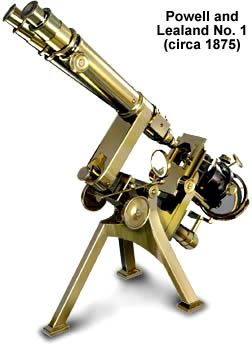The Powell and Lealand "No. 1"
This beautiful microscope, made in 1875 by a partnership between Hugh Powell and his brother-in-law Peter Lealand, has come to be regarded as one of the most famous microscopes of all time. The attention to detail given this microscope is complemented by the expert craftsmanship and high-quality glass used in the lenses.

The basic design remained the same for almost 40 years and today, the microscope has become a highly-prized collectors item. Built with enough weight to minimize vibration, the tripod foot is a solid foundation upon which the precision optical components of this microscope are clustered. Three body tubes were available: an English long tube (tube length = 222 millimeters), a Continental short tube (tube length = 160 millimeters), and a Wenham-type binocular tube that is shown in the illustration above.
Coarse focusing is achieved through a rack and pinion mechanism cut into a thick trapezoidal bar holding the body, and fine focusing is through a long lever that traverses the arm supporting the body tube. A Turrell-type mechanical stage had gradations to help localize specimen details, and can be rotated a full 360 degrees. The condenser, which is capable of some rotation, is also on rackwork for focusing and can be centered by a pair of screws. Beneath the condenser is a plano-concave reflecting mirror fitted to a collar that rides on the lower limb.
A number of accessories were available for this microscope including a wide spectrum of objectives and eyepieces, as well as an epi-illuminator, Nicole prisms, filters, and achromatic condensers.
To gain a more complete understanding of the microscope, we invite our visitors to peruse this quote (according to Gerard Turner's The Great Age of the Microscope) from the Powell & Lealand catalog, published in 1875 at the time of the microscope's introduction:
No. 1--Large Compound Microscope, on an improved construction, with 1-inch of motion to the stage in rectangular directions by screw and pinion; slide holder and spring clip; also wheel and pinion which rotates the whole concentric with the optical tube, combined with very thin stage for the oblique illumination of objects, either by the mirror or achromatic prism, with graduated silver circle, which can be used as a goniometer; coarse and fine adjustments to the body, with graduated sliding tube; substage, with rotary, rectangular, and vertical motions, for the adaptation of the achromatic condenser, paraboloid, &c.; graduated stage plates and clamp, to act as finder; large plane and concave mirrors, with double arm, and 2 eye-pieces...£38.
Wenham's binocular arrangement for low powers, with 3 eye-pieces...£8 10s.
Powell & Lealand's patent ditto, which allows the highest powers to be used with it...£3 3s.
BACK TO NINETEENTH CENTURY MICROSCOPES
